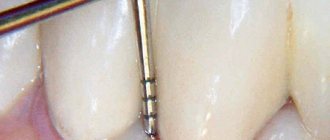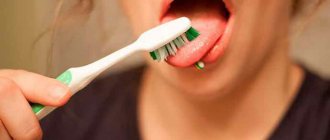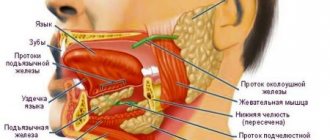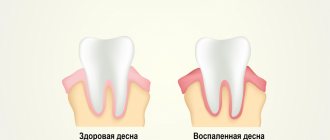What is periodontitis?
You need to know an enemy, and especially such a formidable one, by sight. Medical encyclopedias report:
“Periodontitis is an inflammatory disease of periodontal tissues.”
To the common man this definition will most likely seem incomprehensible. Therefore, in order to understand how insidious this dental disease is, it is worth remembering what periodontium is and its structure.
Periodontium is periodontal tissues whose main task is to hold the tooth in the socket.
Periodontium includes:
- Gums are soft tissues that surround part of the tooth root and protect it from external influences.
- Bone bed of the tooth or alveolar process. It consists of bone plates, and is penetrated by vessels and nerves.
- Periodontium is connective tissue that fills the space between the bone bed and the tooth itself.
- Cementum is the tissue that covers the root of the tooth.
So, periodontitis is a pathological process that affects all, without exception, periodontal structures. Beginning as inflammation of the gums, over time it spreads to the connective tissue and alveolar ridge. It is easy to guess that at a late stage the disease leads to loosening and loss of teeth. And the destruction of the ligamentous apparatus and bone bed makes the process of prosthetics impossible.
Stages of periodontitis
In its development, the disease successively passes through 2 stages:
- Initial . The patient periodically begins to notice blood on the toothbrush, sometimes feels itching and numbness in the gums. At this stage, the dentist diagnoses gingivitis - inflammation of the soft tissues.
- Developed . The gums become inflamed, bleed more often, and their contour begins to change. The patient is already uncomfortable drinking cold drinks and foods, and the general body temperature rises to low-grade fever. Over time, the situation only gets worse: teeth become loose, scattered, and later fall out.
If you seek help from a dentist, you can achieve a stage of stabilization or remission
periodontitis. This is not a complete cure, but only a subsidence of the inflammatory process.
A new exacerbation is possible even after a few months, or perhaps the patient will not remember about the problem for many years. It all depends on the timeliness of visiting a doctor and on how conscientiously his instructions will be followed.
The difference between periodontitis and periodontal disease
Very often, patients confuse periodontitis with a rarer, but no less insidious disease - periodontal disease. In both cases, we are talking about pathologies of the periodontium - the tissues that hold the tooth in the bone. But there is a huge difference between these two diagnoses.
- Periodontitis is an inflammatory disease that is widespread among the population. Periodontal disease can develop quickly and aggressively, making it possible to detect it in the early stages;
- Periodontal disease is not an inflammatory process, it is a systemic lesion of the periodontium, which leads to atrophy of the bone bed of the tooth. The disease is rare: no more than 2% of the population. Periodontal disease is characterized by a slow, asymptomatic course.
If the gums in the area of 1-2 teeth are affected, bleeding is present and swelling of the soft tissues is clearly visible, we can confidently speak of periodontitis. Periodontal disease always affects the entire oral cavity, and is detected in most cases very late, when the bone tissue has already severely atrophied.
Gum massage
Regular gum massage activates blood flow and metabolism in damaged tissues, stimulates healing processes.
Lemon
Essential oils contained in lemon peel have a pronounced anti-inflammatory and antiseptic effect. In addition, a large amount of natural vitamin C helps strengthen the walls of blood vessels and eliminate bleeding. Every evening you should massage your gums with a small piece of lemon peel.
Before using, crush the lemon peel with your fingers for a few seconds. This will increase the release of essential oils and increase the effectiveness of the procedure.
Sea buckthorn and fir
Equal proportions of sea buckthorn and fir oils are mixed until smooth and, after dipping the index finger wrapped in a bandage in the mixture of oils, massage the gums for 8-10 minutes. This procedure must be done twice a day. This massage will increase blood flow in damaged tissues and speed up healing.
Tea tree
Tea tree is one of the most powerful natural antiseptics. It also has a positive effect on the source of inflammation and stimulates tissue regeneration. Apply a few drops of natural tea tree oil to clean fingertips. Actively massage the gums in the affected area for 3-4 minutes. After the procedure, you should not eat or rinse your mouth.
Read more about the beneficial properties of massage in the article - Gum massage.
Symptoms of periodontitis
The onset of periodontitis is almost invisible to the patient. Few people consider itching in the gums, minor discomfort during chewing and bad breath to be a good reason to visit a dentist. Patients begin to think about the need for treatment later: when the gums begin to bleed, react painfully to brushing their teeth, become inflamed and swell. If no action is taken at this stage, the teeth will soon begin to loosen. Advanced periodontitis can no longer be ignored. It is characterized by: increased body temperature, inability to chew due to sore gums, displacement and loss of teeth.
How do proton pump inhibitors work?
There are more than 500 drugs to treat ulcers
This fancy name actually refers to a group of drugs that block the synthesis of hydrochloric acid. This occurs due to the disabling of the enzyme that transports such a component of the acid formula as hydrogen ions into the stomach cavity. This blockade continues until new enzyme molecules are synthesized.
These medications include Pariet, Omez, Nexium, Omeprozole, Pantoprozole, Lansoprozole, Rabeprozole. All of them are very effective, maintaining a favorable environment for mucosal defects to heal and the symptoms of dyspepsia to disappear. This is facilitated by maintaining the therapeutic effect for 7-12 hours after administration. Healing of duodenal ulcers occurs within 2-4 weeks.
Causes of periodontitis
Dentists say the main culprit in the occurrence of periodontitis is bacterial plaque. If you do not remove it from the surface of your teeth in time, over time it hardens and turns into tartar. It, in turn, contributes to the formation of a gap between the gum and tooth, which is commonly called a periodontal or periodontal pocket. As a result, it becomes increasingly difficult to maintain oral hygiene: food debris gets clogged into the resulting gap and provokes an inflammatory process.
The rapid formation of tartar is not necessarily a sign of poor hygiene. The cause of the pathological process may be reduced secretion of saliva, which naturally cleanses the oral cavity. This problem often occurs during long-term use of antidepressants and anti-inflammatory drugs.
The disease can also develop due to a lack of vitamins and microelements. Thus, a lack of calcium will certainly affect the entire skeletal system of the body, and a deficiency of vitamin C reduces the strength of connective tissue. In adults, periodontitis can be a payback for the habit of chewing on one side and a dislike for solid foods: raw vegetables and fruits - ideally, the load on the teeth should be even, and the gums need daily training.
Treatment of periodontitis in dentistry
Periodontitis is an insidious disease: it never heals spontaneously. But you just need to start the process a little, and you can no longer talk about a complete cure, but only about going into remission. Therefore, at the first symptoms of gum inflammation, it is worth carving out a few hours from your busy work schedule and contacting an experienced dentist.
Modern medicine is not at all helpless in the face of illness. Doctors have a variety of conservative, hardware and surgical methods of treating periodontal disease in their arsenal. Which one will be most effective in each specific case can only be determined by a specialist.
Surgical intervention
The main criterion for the need for surgical intervention is an increase in the depth of the periodontal pocket and obvious progression of the inflammatory process, despite drug therapy.
There are several methods of surgical treatment of periodontitis. All of them are aimed at stopping the pathological process, eliminating periodontal canals, and preventing the patient from losing teeth.
Open curettage or flap surgery. Allows you to clean the deepest periodontal pockets, and is performed under local anesthesia. To reach the affected areas, the doctor makes an incision and peels away the gum. And then, using hand tools or using ultrasonic devices, he carries out a thorough cleaning. After this, the cavity of the pockets is filled with osteogenic preparations, and a suture is placed on the gum.
Gingivectomy. This is an operation to remove the excess edge of the gum when it grows excessively. Its goal is to eliminate periodontal pockets in order to prevent the spread of the process from soft tissues to the ligamentous apparatus and bone bed of the tooth. It is performed either under local or general anesthesia.
Splinting. It involves installing a removable or non-removable splint on the inner surface of the teeth, the task of which is to fix the teeth in the correct position and prevent them from moving. This procedure allows you to save teeth even with advanced periodontitis and severe loosening.
If the cause of periodontitis is a malocclusion or a shortened frenulum, the first thing a specialist will do is correct the anatomical disorders. And there are no age restrictions for this.
100% discount on periodontist appointments!
Moscow
Laser treatment
Very often, surgical treatment of periodontitis is supplemented or replaced by a laser curettage procedure. This is a bloodless, minimally invasive method that requires local anesthesia only in patients with a low pain threshold.
In Western Europe, laser curettage has been used for the treatment of periodontitis for about 15 years. Experience has shown that the method is effective for all forms of the disease and guarantees a stable, long-term effect.
During the procedure, the doctor applies a photosensitizer gel to the gums. Then the light guide of the device is inserted deep into the affected periodontal pocket. The next step is to activate the gel with a thin laser beam, which instantly coagulates the infected tissue. Moreover, only pathogenic flora is subject to destruction; neither the laser nor the photosensitizer has any effect on healthy areas of the gums.
The result of laser treatment of periodontitis is complete sterilization of periodontal pockets, on the walls of which a protective photocoagulation film is formed immediately after the procedure. It prevents the penetration of pathogenic bacteria between the gum and tooth, and promotes the rapid closure of the periodontal pocket.
The duration of the laser curettage procedure is no more than 3 minutes. If the disease is detected at an early stage, the affected areas can be completely cured in just one visit to the dentist. In advanced cases, 2 or more procedures may be required, which are carried out with a break of 1 week.
Ultrasound treatment
At the initial stage of development of periodontitis, gum inflammation can be eliminated by simply removing tartar. This type of teeth cleaning is called scaling and is carried out using ultrasonic instruments. One of the most common is the Vector device, developed by the German company Durr Dental.
Unlike traditional scaling, Vector deals with deposits painlessly for the patient. Under high pressure, the device delivers a Fluid Polish polishing suspension to the treated area, which destroys the biofilm on the tooth surface without affecting the root cement and without injuring the soft tissue. This delicate approach allows not only to shorten the treatment period for periodontal disease, but also to avoid the use of antibiotics.
Vector therapy is indicated for patients with any stage of periodontitis. At an early stage, the method leads to complete cure. In more advanced cases, ultrasound scaling precedes surgical treatment.
Ointments
The use of ointments is no less effective than the use of other drugs. Doctors advise using compounds that have antibacterial, anti-inflammatory, healing, analgesic and soothing properties. Ointments allow you to quickly get rid of the pain that occurs with periodontitis.
Let's look at the most common medications of this type:
- Holisal. It is most popular because this ointment has almost no contraindications. Promotes wound healing, relieves swelling, and actively coagulates bacterial cells. Can be used not only for adults, but also for children.
- Solcoseryl dental. It is also a very effective drug that promotes wound healing and improves blood flow in the gums. The components included in its composition help improve cellular metabolic processes and restore the cell membrane.
- Metrogyl denta. The ointment is considered very effective because it contains components that actively fight fungal, bacterial and viral infections. The drug contains two powerful components: metronidazole and chlorhexidine. The first is an effective destroyer of pathogenic microorganisms, the second is antimicrobial, helping to eliminate the disease.
Modern dentistry has an impressive number of drugs that allow you to treat periodontitis at home. But they all require a thorough professional diagnosis of the disease, which can only be carried out by a specialist.
Treatment with medications at home
Treatment of periodontitis is always complex. But if surgical methods are not indicated for everyone and not always, and they are increasingly being replaced by hardware procedures, then drug therapy is a mandatory element of treatment. It includes the following:
- antiseptics;
- steroidal and non-steroidal anti-inflammatory drugs;
- immunomodulatory agents.
It is impossible to cope with periodontitis on your own at home! No miraculous toothpastes, magic toothbrushes or even injections will help if you do not eliminate the main cause of inflammation - bacterial plaque and tartar. Therefore, the medicinal method of treating periodontitis will bear fruit only after the dentist has cleaned the teeth, and, if necessary, undergone surgical intervention.
In almost all cases, dentists insist on treating periodontitis with antibiotics. They can be local, in the form of ointments or gels. But more often, broad-spectrum drugs are prescribed: Trichopolum, Doxycycline, Metronidazole. It is recommended to take them in the form of tablets; less often, the dentist may recommend injections.
Antibacterial agents against Helicobacter pylori
One of the tests prescribed by your doctor may be a blood test for antibodies to Helicobacter pylori. And this is not accidental, since according to data from various sources, it is this bacterium that is resistant to hydrochloric acid that in the vast majority of cases is the cause of peptic ulcer disease.
Medicines for stomach and duodenal ulcers: De-Nol
If this bacterium is not eliminated, regardless of the effectiveness of the drugs used to treat the ulcer, the risk of relapse of the disease and a decrease in periods of remission are very high. There are several treatment regimens for such bacterial infection, the main drugs in which are antibiotics of the nitroimiazoline group - Tinidazole, Metronidazole, Tetracycline.
Since these drugs have been on the drug market for a long time, their effectiveness is increasingly being questioned. This is due to the increased resistance of bacterial strains to this group of antibiotics. They were replaced by more modern antibiotics from the macrolide group. They have many advantages, and significantly fewer side effects and contraindications.
We must not forget about the extremely aggressive environment in which antibiotics have to “work” in the gastrointestinal tract. They must resist the effects of hydrochloric acid, the production of which increases significantly during peptic ulcer disease. The most stable antibiotic in this group is Clarithromycin. It is used in combination with other drugs in a dosage of 0.5 g twice a day.
Treatment with folk remedies
Methods known to our grandmothers help strengthen the gums and relieve inflammation, especially at the initial stage of the disease.
The main thing to remember: alternative treatment must be agreed with the attending physician and carried out under his supervision.
The most effective means for treating gums are:
- Massage the gums using circular movements of the pads of the thumbs. You need to do it in the morning and evening for 5-10 minutes. To make the effect more noticeable, simultaneously with the massage, it is worth rubbing honey, sea buckthorn or fir oil into the soft periodontal tissues.
- Rinse. They are performed immediately after brushing your teeth with comfortable-temperature decoctions and tinctures diluted with water. To make them, they use calendula flowers, oak bark, string, celandine and pine needles.
- Applications. For them you can use honey, beeswax, sea buckthorn oil, Kalanchoe juice.
Histamine blockers – control the production of hydrochloric acid
The ability to maintain an optimal level of acid-base balance directly contributes to the scarring of defects in the mucous membrane of the stomach and intestines. It is desirable that this balance be maintained for a month for 18-20 hours a day, this significantly reduces the number of complications from peptic ulcer disease.
The most commonly prescribed drugs are Ranitidine or Quamatel (Famotidine). Ranitidine is prescribed for peptic ulcers at 300 mg daily for a month. To prevent relapses, this amount is halved (150 mg). Kvamatel is taken in the same way, that is, to obtain a therapeutic effect you need 40 mg, to prevent complications - 20 mg per day.
These drugs help stop bleeding of mucosal defects (Kvamatel). In addition to the above, Roxatidine, Cimetidine, Famotidine have the same effect. Their antisecretory effect extends for a period of 10-12 hours, for Cimetidine - 5 hours.
Is it possible to restore gums?
Periodontitis is a disease that greatly impairs the aesthetics of a smile. That is why dentistry has long and successfully used a surgical method of gum restoration - gingivoplasty. With its help, you can change the height of the gum, improve its structural condition, restore atrophied tissue or, conversely, remove excess.
Contraindications to the operation are: diabetes mellitus, cancer, decreased blood clotting, and inability to use anesthesia.
In other cases, after carrying out anti-inflammatory procedures and achieving stable remission, you can safely start a conversation with your doctor about gingivoplasty.
Types of periodontitis
To select an effective treatment, the dentist must first determine the causes of periodontitis and identify the nature of the disease. Therefore, the classification of periodontitis is not so much of scientific interest as it contains the ability to predict the further development of the situation and select those treatment methods that will give the best result.
One or another type of periodontitis can be diagnosed based on 3 criteria: severity, course of the disease and localization of the process.
By severity
To determine the severity of the disease, dentists evaluate the depth of the periodontal pocket, tooth mobility and the degree of bone tissue resorption:
- with mild periodontitis,
the teeth are immobile, the depth of the periodontal canal does not exceed 3.5 millimeters. The height of the interdental septa is still slightly reduced: no more than one third of its length; - with moderate periodontitis,
the height of the interdental septa is reduced by half its length, the periodontal pockets deepen to 5 millimeters, and the teeth begin to slowly shift; - Severe periodontitis
is visible to the naked eye even when talking to a person. The teeth are displaced and gaps form between them. And the patient complains of severe pain, bleeding, and sometimes the discharge of pus from the periodontal canals.
Severe periodontitis is statistically observed in 15-20% of people over 35 years of age.
With the flow
The course of the disease can be acute or chronic. The acute form of periodontitis is very rare and does not affect the entire oral cavity, but a small area of the gums. It occurs as a result of injury to soft tissues as a result of an impact, an incorrectly installed crown, or a broken piece of tooth.
Acute periodontitis develops at lightning speed and causes severe pain, with which the patient usually rushes to the dentist. The chronic process is characterized by a wave-like course and coverage of the entire oral cavity. When the disease enters the remission stage, the patient mistakenly believes that he is completely cured. But after a few months everything repeats itself, and this time the signs of inflammation will be more pronounced.
With timely consultation with a doctor, acute periodontitis can be cured quickly and effectively. If periodontitis has entered the chronic stage, the prognosis is less favorable.
By localization
Depending on how extensive the area is covered by the pathological process, periodontitis is distinguished:
- localized
or
focal
; - generalized
.
In the first case, the disease manifests itself in only one or several teeth. And dentists talk about the activation of secondary factors. This means that the development of periodontitis could be triggered by a poor-quality filling, contact with arsenic paste or filling material on the gums, careless installation of a prosthesis, and even injury to the gums by dental floss.
In the generalized form of periodontitis, the gums, connective and bone tissue on two rows of teeth are affected. This is typical for the chronic course of the disease, which is much more difficult to treat.
Gastroprotectors – protection of the mucous membrane
Drugs of this pharmacological group are also included in the complex treatment of peptic ulcer disease. They create an enveloping protective shell on the surface of the mucous membrane of the intestines and stomach. The main active ingredient in most of them is bismuth salts: De-nol, Vikair, Vikalin, Sucralfate, Carbenoxolone, Misoprostol.
De-nol, in addition to creating a protective film on the ulcerative surface, promotes their scarring. Carbenoxolone is based on licorice root. It increases the viscosity of mucus, making it a reliable barrier between the walls of the stomach and duodenum and pepsins with hydrochloric acid.
It is perfectly excreted from the body through the intestines. Increased blood pressure is one of its serious side effects. Misoprostol is also a very effective remedy for peptic ulcers, despite its side effect of diarrhea.
Diagnosis of the disease
The main diagnostic method for suspected periodontal disease is measuring the depth of the gap between the gum and tooth. In a healthy person it does not exceed 1-2 millimeters. The procedure is carried out using a periodontal probe, a thin instrument with millimeter notches.
If the process is generalized, the doctor measures the periodontal pockets of each tooth, records the obtained indicators and draws up a periodontogram. In the future, it will make it possible to evaluate the effectiveness of treatment or, conversely, to detect the progression of the disease in time.
X-ray examination is important for diagnosing periodontitis: panoramic X-ray or layer-by-layer scanning. It allows you to identify loss of bone tissue and its sclerotic changes.
In very severe cases, the doctor may refer the patient for further examination: measure the degree of hypoxia in the gums, determine the quality of the periodontal microvasculature, examine bone tissue for density.
Prevention of periodontitis
The best prevention of periodontitis is proper oral care. You need to brush your teeth at least 2 times a day: before breakfast and before bed. Moreover, the procedure should take at least 3 minutes, and the main movement when cleaning is from the root to the cutting edge of the tooth. Don't ignore dental floss. They perfectly clean the interdental spaces and prevent the development of pathogenic bacteria.
If the disease has already manifested itself, pay attention to your toothbrush. Her stubble should be stiff. And even if at first brushing your teeth with its help seems uncomfortable, over time your gums will get used to it. You need to change your toothbrush every 1.5 months.
Author: Maria Kozodaeva Candidate of Medical Sciences. Dentist-therapist, endodontist, periodontist, implant surgeon. Work experience more than 11 years.
The information is for reference only. Before treatment, consultation with a doctor is necessary.
How to determine the need for treatment of stomach and duodenal ulcers
Destruction of the integrity of the mucous membrane is an ulcer
An ulcer is a destruction of the mucous membrane, exposing the underlying layers of the wall of the stomach or intestines. Since the history of the appearance of such pathology in the stomach and intestines has much in common, the same medications are used for stomach and duodenal ulcers.
With the development of a peptic ulcer, a sharp pain is felt “in the pit of the stomach”; these pains can be acute, or similar to “hunger pains”. They appear 2-3 hours after eating, accompanied by vomiting, nausea, and a feeling of heaviness in the epigastric region. Bloating, belching, flatulence, and complete lack of appetite are constant companions of this disease.
With such symptoms, you should urgently consult a gastroenterologist, surgeon, or therapist. The specialist will conduct a gastroscopy, laboratory tests to clarify the diagnosis, and prescribe medications for stomach and duodenal ulcers.
It is extremely dangerous to self-medicate, following information received from friends and acquaintances, as well as rely entirely only on traditional medicine methods. A gastroenterologist currently has more than 500 modern medications in his arsenal, which can be selected taking into account the individual characteristics of the body.











